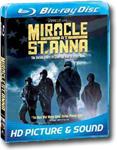 |
|
|||||||||||||||||||||||||||||||||||||||||||||||||||||||||||||
Save perhaps the Civil War, no other singular event has shaped who we are as a nation as much as WWII. Along with our emergence as a superpower, important cultural and societal improvements we made as a nation stemmed from the war as well, including the struggle for civil rights for all Americans regardless of race. As director Spike Lee points out in the special features documentary, African-American soldiers, after risking their lives in service to this country, simply had had enough of being treated as second-class citizens again at war's end. Set in WWII, Lee's Miracle at St. Anna Like many of Lee's movies, the film starts off terrific. It opens in 1984 as an elderly African-American man sits alone in an apartment, watching a John Wayne WWII movie ("We were in that war, too, pilgrim," he says bitterly). It cuts to the old man at work at the U.S. Postal Service. He commits a shocking act of violence while on duty. The investigation of why he did it, as well as the subsequent discovery of a mysterious statue head in his apartment, set in motion the remainder of the film. From there, the film moves to the Tuscany region of Italy in 1944. A squadron of the Buffalo Soldiers moves in place for battle across a narrow creek. In a brilliant move, Lee shows a radio truck move behind the fortified German Battalion as Axis Sally spews propaganda over the loudspeaker to the advancing soldiers (like the Devil, she expertly weaves truth into her propaganda, calling into question [with, sadly, some merit] why these soldiers would risk their lives for a country that does not value them). The way the men look at each other as they advance into position while Sally's rant continues creates almost unbearable tension. However, also like many of Lee's other movies, the film loses momentum after this battle scene and begins to drag in the middle. Keeping a tight story structure has never been his strong point; he tends to pad his films with extraneous scenes too often in order to get his particular point across. Furthermore (and again, as in other work of his), he pads this film with a few too many characters and puts in too many story arcs, making the film hard to follow at times. Finally, the "happy" ending (which I dare not reveal) feels a bit too contrived and fails to pack the emotional wallop that it should have (and is too similar to the ending of Shawshank Redemption Still, there is much to admire in this film. As pointed out in other reviews, one of the more extraneous scenes is also one of the most poignant: the four soldiers flash back to their basic training in Louisiana. While on furlough, they enter an ice cream shop and are refused service by the white owner, while four German POWs are sitting at a nearby booth eating. (On a personal note, for me, being a white Southerner and knowing that such treatment of African-American servicemen sadly actually happened, seeing such a scene is humiliating and painful to watch.) Again, such a scene is perhaps not essential to the plot, yet it pointedly highlights an underlying theme of the film - namely, how the Buffalo Soldiers were perhaps treated with more respect and humanity by the Italians, the so-called enemy, than in their own country. Overall, Miracle at St. Anna Extras: As expected from a Blu-ray disc, the sound and picture are crystal clear. The high-quality picture highlights the usual outstanding work by Lee's longtime cinematographer Ernest Dickerson (easily one of the best cinematographers working today). Just as valuable on the Blu-ray are two brief but powerful extras not included on the standard DVD. Feature One, "Deeds Not Words," is perhaps the strongest aspect of the disc, even more so than the film. At an American Legion post in Harlem, Lee and author James McBride have a roundtable discussion with four Buffalo Soldier veterans, as well as with two veterans of the famed Tuskegee Airmen. During this brief but informative discussion, the veterans offer their experiences during and after the war. To hear how these men, who put their lives on the line for this country, were treated as second-class citizens is painful and humiliating (again, some reiterate that they felt they were treated with much more respect by the Italians than they were in their own country). However, their story is very important and must be heard and remembered. (I would not mind a bit if Lee's discussion with these veterans was played in high school history classes across the country.) Feature Two, "The Buffalo Soldier Experience," is an extremely insightful documentary on the history of the Buffalo Soldiers, from their inception just after the Civil War through their service in Italy during WWII. It seamlessly blends interviews from professors, historians, veterans, and cast and crew from the film with archival footage of the soldiers. Like the interviews, much of what is told is tough to hear but important. Deleted scenes and previews from other films are also included. |
|
|||||||||||||||||||||||||||||||||||||||||||||||||||||||||||||
|
||||||||||||||||||||||||||||||||||||||||||||||||||||||||||||||
| action | animation | art house/international | comedy | documentary | drama | family | horror/sci-fi | suspense | television | ||||||||||||||||||||||||||||||||||||||||||||||||||||||||||||||
| contact | home | ||||||||||||||||||||||||||||||||||||||||||||||||||||||||||||||



